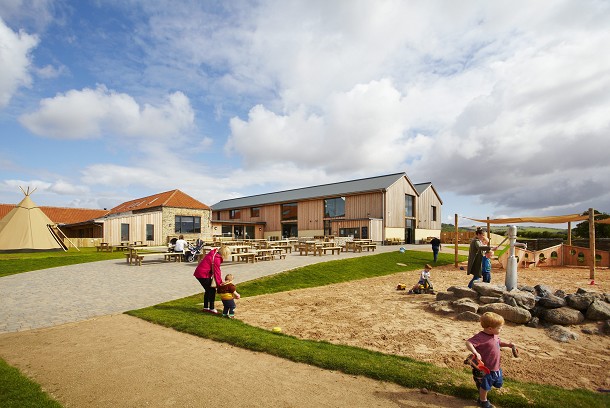
A Sustainable Approach to Design
Native Architects create well-crafted buildings and structures using sustainable, low carbon methods and authentic conservation techniques to maintain and enhance our built environment for current and future generations. This can be seen in our design for William’s Den.
William’s Den is a great example of rural estate and farm diversification. It is a new and exciting adventure attraction, giving children the chance to connect with nature and get active as they explore a custom designed complex that brings the great outdoors inside.
Working with a large interdisciplinary team, Native led the design for the new William’s Den visitors centre that includes the conversion of Listed farm buildings to create a commercial kitchen serving a large double height restaurant incorporating a feature wood fired pizza oven, bar, and ice cream parlour.
A new two storey play barn, is connected to the listed barns by a single storey timber framed, timber clad linking structure, which incorporates a gift shop and entrance foyer.
Native specify renewable bio based insulation materials that have a low carbon footprint, are recyclable and do not emit harmful gasses to pollute internal air.
The project has incorporated a range of sustainability measures. The buildings are heated by a biomass district heating scheme with solar photovoltaic roof panels to provide renewable energy generation onsite. The building fabric has been highly insulated using low carbon, renewable and recycled construction materials where possible to lower the amount of energy needed to heat and cool the building.
By using lime (instead of cement), timber, hempcrete and high performance wood fibre insulation materials throughout the build, the client has reduced the amount of CO2 emitted during the construction phase and further enhanced their sustainability credentials. Low toxic, natural materials allow the building to ‘breathe’ and maintain good internal air quality.
A further breakdown of the materials specified for this project include:
For the play barn Hempcrete blocks were used. This was the largest order of hemp blocks in the UK at the time. The blocks, manufactured by Equilibrium, are an environmentally friendly building material, being insulating, breathable, and “better-than-zero-carbon” – the hemp contained in the blocks absorbs more atmospheric carbon dioxide as it grows than is emitted in making the blocks, including the manufacture of the lime ‘binder’. This atmospheric CO2 is then locked up (‘sequestered’) for the lifetime of the building.
The wall and roof insulation employed was largely wood fibre which is composed of waste wood which would otherwise be lost to landfill. It is inert, has no harmful chemicals within it and helps to even out internal temperature variations.
The floors throughout the project are insulated with recycled foamed glass. This glass is not commercially viable to recycle and would otherwise go to landfill. Using this product prevents tonnes of waste glass going to landfill per year. This was one of the largest orders of foam glass insulation in the UK.
All the ceilings are finished with wood wool board which is manufactured from sawmill waste. This has a low carbon footprint and has significant benefits in terms of absorbing sound - which is crucial in the play barn!
A word from Native Architects...
When considering your building project be sure to think about the materials you use. Native Architects are able to help you specify low toxicity, renewable construction materials that give increased performance, create healthy indoor environments and help lower the impact your project has on the environment.
Contact
Native Chartered Architects Ltd.
1 Howden Lane, Crockey Hill, York,
YO19 4SW
Tel: 01904 656133
Email: info@nativearchitects.com


